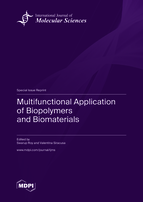Multifunctional Application of Biopolymers and Biomaterials
A special issue of International Journal of Molecular Sciences (ISSN 1422-0067). This special issue belongs to the section "Materials Science".
Deadline for manuscript submissions: closed (30 June 2023) | Viewed by 31337
Special Issue Editors
Interests: biomaterials; edible film and coatings; nanoemulsion; natural compound; active food packaging; smart packaging materials; food shelf life
Special Issues, Collections and Topics in MDPI journals
Interests: packaging materials; bio-based and biodegradable polymers; bio-based and biodegradable polyesters; green composites; polymerization of biopolymers; processing of bioplastics; sustainable polymer for food preservation; biopolymers for food packaging; edible films; compostable packaging; monomers from renewable resources; polymers from renewable resources; gas barrier properties; life cycle assessment (LCA) study; bioeconomy; circular economy
Special Issues, Collections and Topics in MDPI journals
Special Issue Information
Dear Colleagues,
Biopolymers and biomaterials are two interlinked key topics of interest in the field of composite materials today. The use of biopolymers and biomaterials is inevitable now or in the near future, as it has already been established that synthetic polymers and chemically synthesized materials are very harmful to both living beings and the environment. The excess use of non-biodegradable polymers has already caused severe damage to the ecosystem, and thus, biobased degradable polymers can serve as the ideal replacement. To this end, biopolymers from various natural sources, such as carbohydrates, proteins, lipids, etc., individually or in a blend version, are being used to create composites for various purposes, such as packaging, biomedical, etc. On the other hand, chemical preservatives are very commonly used items in food items to enhance food shelf life, but recently, numerous reports have shown their negative impact. In this context, to improve the physical properties of biopolymer-based composite materials and their functionality, biomaterials are superior to chemically produced synthetic toxic materials. Some biomaterials with value-added functional properties are bioactive compounds, plant extract, essential oils, natural colorants, etc. The combination of biobased polymers and biomaterials can be useful to the manufacture of functional composite materials.
The main goal of this Special Issue is to collect recent progress in the preparation of biobased composite materials utilizing biopolymers and biomaterials for potential applications including but not limited to packaging, biomedical regime, and cosmetics. The themed research topic is expected to provide more awareness of the use of biobased polymers and biomaterials in innumerable aspects of our daily used items.
Dr. Swarup Roy
Dr. Valentina Siracusa
Guest Editors
Manuscript Submission Information
Manuscripts should be submitted online at www.mdpi.com by registering and logging in to this website. Once you are registered, click here to go to the submission form. Manuscripts can be submitted until the deadline. All submissions that pass pre-check are peer-reviewed. Accepted papers will be published continuously in the journal (as soon as accepted) and will be listed together on the special issue website. Research articles, review articles as well as short communications are invited. For planned papers, a title and short abstract (about 100 words) can be sent to the Editorial Office for announcement on this website.
Submitted manuscripts should not have been published previously, nor be under consideration for publication elsewhere (except conference proceedings papers). All manuscripts are thoroughly refereed through a single-blind peer-review process. A guide for authors and other relevant information for submission of manuscripts is available on the Instructions for Authors page. International Journal of Molecular Sciences is an international peer-reviewed open access semimonthly journal published by MDPI.
Please visit the Instructions for Authors page before submitting a manuscript. There is an Article Processing Charge (APC) for publication in this open access journal. For details about the APC please see here. Submitted papers should be well formatted and use good English. Authors may use MDPI's English editing service prior to publication or during author revisions.
Keywords
- biopolymers
- nanomaterials
- biomaterials
- functional materials
- bioactive natural compounds
- essential oil emulsion
- natural colorant
- plant extract
- bioactive compounds
- nanocomposite
- functional composite
- composite film and coatings








